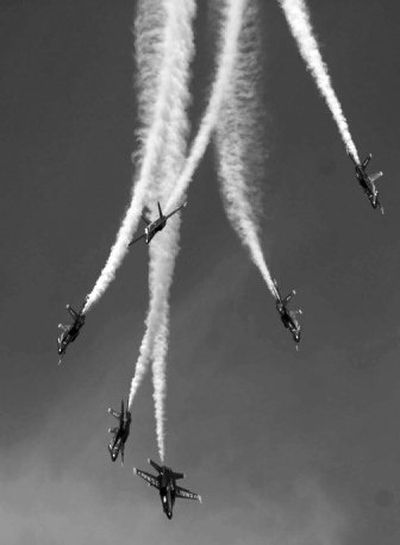Blue Angel crashes during air show, killing the pilot

BEAUFORT, S.C. – A Navy Blue Angel jet crashed during an air show Saturday, plunging into a neighborhood of small homes and trailers and killing the pilot.
Witnesses said the planes were flying in formation during the show at the Marine Corps Air Station at about 4 p.m. when one dropped below the trees and crashed, sending up clouds of smoke.
Raymond Voegeli, a plumber, was backing out of a driveway when the plane ripped through a grove of pine trees, dousing his truck in flames and debris. He said wreckage hit “plenty of houses and mobile homes.”
“It was just a big fireball coming at me,” said Voegeli, 37. “It was just taking pine trees and just clipping them.”
Witnesses said metal and plastic wreckage – some of it on fire – hit homes in the neighborhood, located about 35 miles northwest of Hilton Head Island. William Winn, the county emergency management director, said several homes were damaged. Eight people on the ground were injured.
The crash took place in the final minutes of the air show, said Lt. Cmdr. Anthony Walley, a Blue Angel pilot. The pilots were doing a maneuver that involved all six planes joining from behind the crowd to form a Delta triangle, said Lt. Cmdr. Garrett D. Kasper, spokesman for the Blue Angels. One plane did not rejoin the formation.
Walley said the name of the pilot would not be released until relatives were notified of the death. A Navy statement said the pilot had been on the team for two years – and it was his first as a demonstration pilot.
Kasper said all possible causes of the crash are under investigation, and it could take at least three weeks for an official cause to be released.
The Blue Angels fly F/A-18 Hornets at high speeds in close formations, and their pilots are considered the Navy’s elite. They don’t wear the traditional G-suits that most jet pilots use to avoid blacking out during maneuvers. The suits inflate around the lower body to keep blood in the brain but could cause a pilot to bump the control stick – a potentially deadly move when flying inches from other planes.
Instead, Blue Angels manage G-forces by tensing their abdominal muscles.
The last Blue Angel crash that killed a pilot took place in 1999, when a pilot and crewmate were killed while practicing for air shows with the five other Blue Angels jets at a base in Georgia.
Saturday’s show was at the beginning of the team’s flight season, and more than 100,000 people were expected to attend. The elite team, which is based at Pensacola Naval Air Station, recently celebrated its 60th anniversary.
The 2007 team has a new flight leader and two new pilots; Blue Angel pilots traditionally serve two-year rotations.
Kasper said the team would return to Florida today. “We will regroup,” he said.